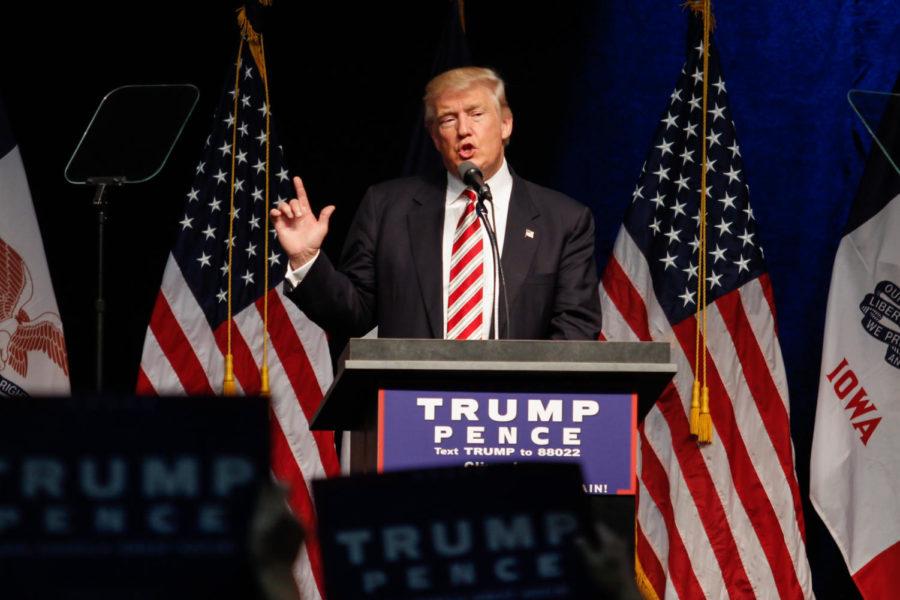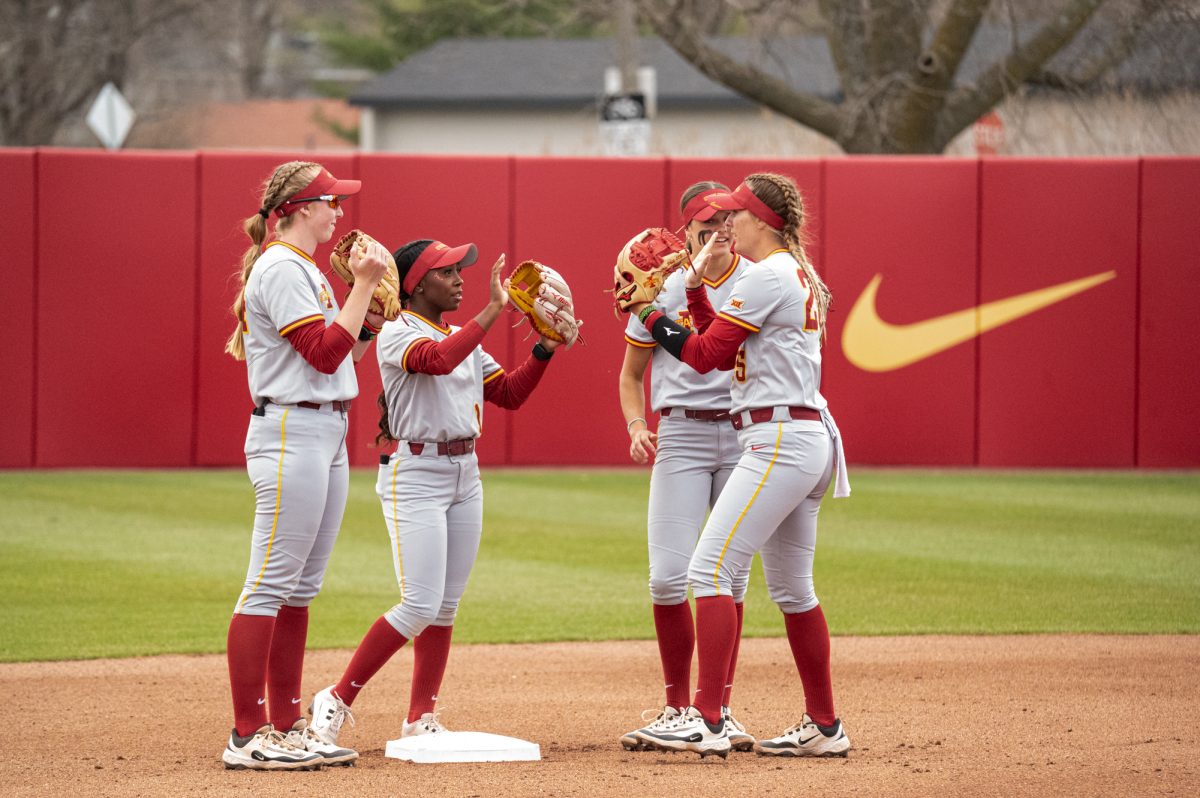Political science professors talk history of State of the Union address
Now-President Donald Trump speaks to the crowd about then-Democratic presidential nominee Hillary Clinton’s emails on Sep. 13, 2016 in Clive, Iowa.
January 29, 2018
From Washington to Trump, Iowa State political science professors feel the State of the Union address has drifted from its original purpose.
The State of the Union address, a requirement by Article Two of the Constitution, used to be much more conversational but has evolved into something with more political fuel.
Before the media attention and political energy of modern State of the Union addresses, Mack Shelley, a political science professor, described the address of the president as wandering over to Congress to inform on achievements and future plans.
Though, at the start of the U.S. Government, there were no political parties and when they formed, the vice president was still the opposite party of the president, so the address remained non-partisan.
Now, political science professor Dirk Deam calls the State of the Union address a show. Shelley said the address at some point became an extension of a political campaign. Party affiliation becomes apparent when paying attention to who chooses to clap at specific parts of the speech.
As President Donald Trump is set to give his first State of the Union address, Iowa State political science predicted which topics will be covered—such as immigration and the economy—and whether Trump will follow the style of past presidents or go with his own style.
“So, what we’re seeing is roughly a century old and not conversational and not necessarily confrontational either,” Shelley said. “But if you’ve got a president who’s, lets say a Democrat like Obama, and a legislature, House and Senate that are both run by Republicans, it’s kind of guaranteed that you’re going to have sparks flying.”
The Constitution requires the president to inform Congress yearly of the State of Union and lay out objectives that they feel need to be accomplished, Deam said.
“Of course in the original Constitution there were no political parties, so the president was simply required to speak … The early days of the Constitution, the president and the vice president were from alternate parties,” Deam said. “What ends up happening is that if you’re up there trying to make a big point about how great your party is and how awful the other party is, you’re not really doing what the State of the Union is supposed to do. You’re trashing your vice president.”
Along with a change to presidents and vice presidents sharing parties, the style of the speech changed as well. Deam said, especially in hard times, the American people look to the president during the State of the Union to provide leadership and restore faith in their country.
Looking back at the presidents he has seen throughout his lifetime, Deam said he saw a change in style during the Ronald Reagan presidency.
“In the Reagan years, Reagan was such a charismatic figure and it was about Reagan’s charisma,” Deam said. “So Reagan began putting people up in the gallery and drawing attention to them … getting everyone excited and weepy over some person who had done something notable.”
This practice became tradition and continues to this day.
Deam described John F. Kennedy’s addresses as a call to action. He said Kennedy focused on plans for the future of the country rather than Kennedy himself.
Deam said Obama had less divisive rhetoric, but brought up partisan issues. He said people may not have liked his policies, but he conducted the presidency in a very traditional way.
“One particular thing that Obama made a point of which was to press for background checks on guns because the State of the Union had occurred at a period right after one of these school shootings,” Deam said. “So you could look at that as a very partisan, political thing if you want to, but it’s a State of the Union. He’s asking for legislation.”
He said Obama avoided bashing the Republicans and the National Rifle Association when bringing up these issues. During George W. Bush’s presidency, he used the State of the Union to push for the war in Iraq.
Deam and Shelley also predicted which topics might make it into President Donald Trump’s first State of the Union address Tuesday.
Deam said this address could go in either direction.
“[Trump] could try really hard to be a sort of be a traditional president and do what presidents are supposed to do with the States of the Union, but he has such a hard time resisting temptation to not do that,” Deam said.
One topic which will likely make his speech is immigration. CNN reported that the president will likely pitch his immigration plan. The plan proposes giving 1.8 million undocumented immigrants a pathway to citizenship.
In exchange, the U.S. would receive $25 billion in order to build a wall along the Mexican-American border.
USA Today published an editorial stating that a healthy economy will likely be a topic at the address, titling the article “Roaring economy gives Trump bragging rights for State of the Union Address.”
“With his pro-growth agenda, Trump has delivered economic prosperity to millions of Americans,” the editorial said. “Job creators and job-seekers alike are benefiting from lower taxes, fewer regulations, and an unwavering commitment to free-market principles not seen since the Reagan years.”
Unemployment is said to be the lowest since 2000 in the editorial and Shelley said the economy is growing at a fairly rapid rate—about 3 percent. He added that this growth doesn’t seem as fast as somewhere like China where 7 percent is seen as slow growth.
“Purely objectively, it’s not wrong to say the economy’s in good shape. It always depends on your indicators, so national unemployment rate is right around 4.1 percent,” Shelley said. “It’s been there for a while, so it’s not exactly a new thing, but Trump I supposed will claim credit whether you can really justify it or not.”
Professor Joshua Rosenbloom from the department of economics said the growth and unemployment rate cannot be attributed to anything done in the last year.
“I think in general presidents get more credit and more blame for what’s happening in the economy than is appropriate,” Rosenbloom said. “In many respects, what happened in the last year in the economy is the result of decisions that were made many years ago.”
Rosenbloom said that it takes expertise to determine the cause of a worsening or growing economy. This requires showing how the outcome may have changed if the policy wasn’t put in place.
Despite this, Trump is expected to take full credit, similarly to many past presidents.
Trump will likely talk about the $1.5 trillion tax plan which the Congress Republicans were able to pass recently, Shelley said. The tax plan benefits wealthy individuals, families, corporations and small businesses.
“So that’s of course a natural, not coal miner type, but more business type part of the Republican constituency. That’s what the tax bill was all about. It was to support what the opposition to him would typically call the ‘donor class,’” Shelley said.
“Donor class” is referring to a claim by Democrats that Republicans give tax breaks to the rich so they will donate to their campaigns in return.
“Republicans sacrificed everything to get that tax plan through. That’s the only ace in the hole they have for the coming reelection, the election in 2018,” Deam said. “They want to trumpet that in all their campaign commercials.”
Another topic which might make its way into the speech is his promise to create more extraction jobs, such as coal mining.
“Well, he’ll certainly drill down—that’s a deliberate play on words by the way—in areas like oil exploration and coal mining, you know that’s part of his working class constituency,” Shelley said. “Part of what motivated his success in states like Pennsylvania, Kentucky, West Virginia, which are kind’ve heavy into mining, extraction industries, was exactly this appeal that he’d bring back jobs for people in coal mining which likely isn’t going to happen.”
Shelley added that bringing back the coal mining industry is an almost impossible promise to make since the world will likely never go back to coal as a primary fuel source.
Shelley said Trump may recognize a coal miner during the address among other people in order to say, as Shelley put it, “I am on your side. This is the kind of person that supports me and I am your president, I support you.”
Deam said he doesn’t find this likely.
It is unclear whether Trump will follow a teleprompter like his predecessors or if he will go back to the style seen often on the campaign trail. Many of his supporters were drawn to his non-politician rhetoric.
“When people criticize [Trump] or feel that they’re offended or put out by the fact that he’s not doing what the presidency normally requires, then [Trump supporters] get thrilled,” Deam said. “They just think it’s great watching the other side suffer.”
The State of the Union address will take place at 8 p.m. on Tuesday, CST.







